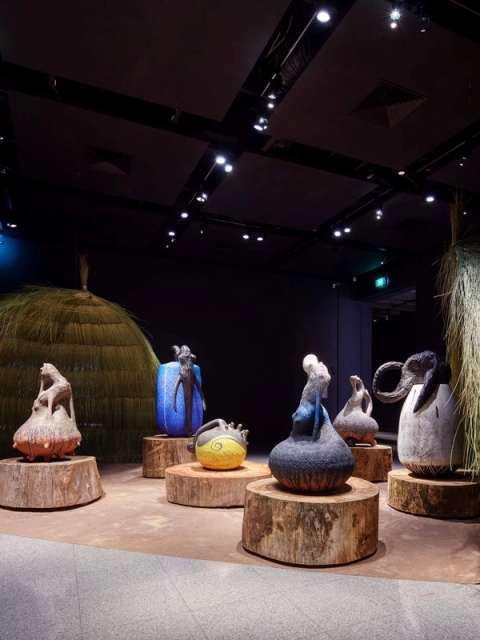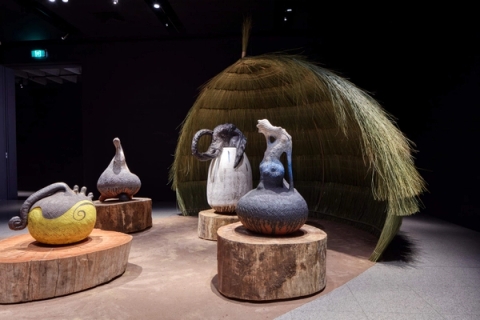My Enquiry (0)
No artwork has been selected.
Please choose an artwork to enquire.
Enquiry Submitted
Thank you for your enquiry and interest in our artists’ work. A member of the gallery team will respond shortly.
000%

Andile Dyalvane and Zizipho Poswa at the first Indian Ocean Craft Triennial in Australia
26 Oct 2021 (6 min) read
“Our intention for iLima is that hands will be laid on the piece by those attending IOTA21, thereby contributing to the energy of the work, as well as engaging with the narrative as part of our connection from across the Indian Ocean."
Andile Dyalvane and Zizipho Poswa are amongst the lead artists of the inaugural Indian Ocean Craft Triennial (IOTA21), currently taking place in Perth and across Western Australia (until end November 2021).
The new arts festival involves over 200 artists working in craft, of which 37 are lead artists from across eight Indian Ocean Rim (IOR) countries, including India, Malaysia, Kenya, Thailand, Singapore, Western Australia, and of course, South Africa.
For IOTA21, Dyalvane and Poswa created pieces individually, as well as one collaborative piece, with all six pieces falling under the overarching series title iZilo, meaning “clan totems”. Their works are on show at John Curtin Gallery in Perth, which is hosting the triennial’s two central exhibitions along with the Fremantle Arts Centre.
In Xhosa culture, clan names, or iZiduko, carry huge importance, bestowing a sense of belonging and identity on individuals. By centering all the pieces around aspects of clan life, Dyalvane and Poswa speak directly to IOTA’s overarching theme of ‘Curiosity and Rituals of the Everyday’. The two ceramicists also collaborated with several other creatives on their shared piece, namely South African sound healer Nkosenathi Koela, local Noongar artist and advisor Barry McGuire, and Fremantle-based weaver Fiona Gavino. This was a way to connect their lands and spirits to Western Australia’s, cementing a coming together that celebrates folklore, clan, community, sound and movement.
“This work weaves together several indigenous cultural sounds to reflect, explore and dive into the ways we are connected and essentially singing the same song, dreaming the same dream, walking to the source together.” explains sounder healer Koela. “This pays homage to all those who have come before us and those who walk with us now to remind us of the ancient medicine within, and how powerful we are when we share that medicine with one another.”
Gavino, an inter-cultural artist using basket making materials and techniques to create contemporary sculpture and installation, contributed to the holistic setting by creating two complementary beehive-shaped grass dwellings, traditionally called uNqguphantsi. She harvested local native Balga fronds to create the thatching beforehand, which was then attached to the frames once in position in the gallery. Lastly, Dave Reid at John Curtin Gallery produced very authentic flooring, based on the recipe provided by us at Southern Guild (the same recipe that was used to create the flooring for Dyalvane’s iThongo exhibition at the gallery in 2020).
iLima (communal contributions)
In their collaborative piece, a large work titled iLima, Dyalvane and Poswa highlight a specific ritual carried out during gatherings in everyday rural life – the act of communal contributions. “When calling on community members to come together for the purposes of a ceremony or an address by a village elder, it is customary for everyone to contribute to and support the undertakings,” explains Dyalvane. “The nature and practice of communal contribution or offering is cycled through the village or community when members attend one another’s gatherings.” iLima is a representation of how both Dyalvane and Poswa translate the details of ceremony and communal spaces and activities into textural and structural landscapes in the clay.
“Our intention for iLima is that hands will be laid on the piece by those attending IOTA21, thereby contributing to the energy of the work, as well as engaging with the narrative as part of our connection from across the Indian Ocean,” Dyalvane shares. The laying of hands on the piece is symbolic of that “community contribution”, unifying viewers and immersing them in clan ritual and narrative.

ILima by Andile Dyalvane; Images by Stephanie Veldman
Qengeba, Ngwanya and Nkwankhwa by Andile Dyalvane
Dyalvane’s trio of works are gestures of Nkwankhwa, one of his clan names, and the clan totem linked to it, ooJola (snake totem). The snake-like forms of the three pieces, titled Qengeba, Ngwanya and Nkwankhwa, pay homage to this totem. “Remembering one’s heritage, culture, language and traditions entails addressing old wounds of displacement and the renaming of individuals that have caused a deep loss of ancestral knowledge,” the artist explains. “In pre-colonial times, people identified themselves primarily by clan name, but with clan names being lost along the way, the connections to ancestral roots have sadly been weakened.”
The various states of emergence of Dyalvane’s three pieces symbolise a rebirth and a reclaiming of those lost clan names. “To diminish the importance of clan lineage is to deny one’s dreams as being significant and deprive oneself of divine guidance,” says Dyalvane. “To proclaim our totems in celebration and praise is to have gratitude for our messenger spirits who actively aid the course of our lives.”

Left to right: Ngwanya, Nkwakhwa and Qengeba by Andile Dyalvane; images by Stephanie Veldman
Gengesi and Mntungwa by Zizipho Poswa
Poswa’s two pieces, Gengesi and Mntungwa, are symbolic representations of her clan totem, iNdlovu (elephant totem). “iNdlovu is the quintessential symbol of the spiritual connection we share with our ancestors,” explains Poswa. “In this work, I am honouring my ancestral lineage, my identity and my cultural heritage. Knowing one’s past is the key to understanding one’s present,” she says. “In the isiXhosa culture, iZiloare extremely important in understanding our essence of being as they help us to retrace the footsteps of our ancestors. These pieces are my way of expressing my gratitude for the messages the totems transmit through me.”
Poswa worked with Malawian wood carver Friday Jibu to create wooden elements representing elephants, which have been attached to the boldly coloured ceramic bases. This is the first time Poswa has incorporated wood into her work.

Left to right: Mntungwa, a detail of Mntungwa and Gengesi by Zizipho Poswa; images by Stephanie Veldman
All six pieces are offerings intended to bring clan names and their power to the fore again, thrusting them into the present and praising them as they should be.

Final installation in the John Curtain Gallery, curated by Maggie Baxter & Jude van der Merwe; images courtesy of Acorn Photography/IOTA21

The Indian Ocean Craft Triennial was founded by a voluntary team of curators, arts managers and academics. “The original plan was to stage just one major exhibition to showcase examples of contemporary craft from around the Indian Ocean Rim,” explains curator Jude van der Merwe. “Both John Curtin Gallery and Fremantle Arts Centre were quick to respond enthusiastically. And once word escaped to the wider art and craft community in Western Australia, we were inundated with requests from galleries and craft groups who wanted to join in. The result is that we now have a large complementing festival supporting the major international exhibition, a conference, a fashion event and a public programme.”
The triennial encompasses more than 30 exhibitions and activities presented by institutions, regional galleries, artist-run collectives and art spaces, in collaboration with a multitude of individual craft artists and craft-specific groups. Everything from film festivals, to workshops, cultural events, small-scale exhibitions and more are on offer.
Van der Merwe continues: “IOTA21 aims to honour and spotlight the talents of skilled craftspeople who, fuelled by curiosity, constantly improve techniques to earn a living or find new ways of expressing our stories and culture. In celebrating the ingenuity of our hands and minds, this in turn aims to inspire us all, to create a relevant, viable and better future through craft.”

